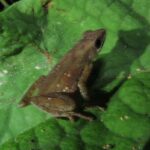- Unveiling the Secrets of <em>Ischnocnema melanopygia</em>: Brazil's Elusive Forest Guardian
- Taxonomy and Classification
- Natural Habitat: Dwelling Beneath Brazil's Lush Canopies
- Physical Characteristics: Small in Size, Big in Adaptations
- Behavior and Life Cycle: Life Without Tadpoles
- Ecological Role: Tiny Guardians of Balance
- Threats and Conservation Status: Small Frogs with Big Challenges
- Cultural and Scientific Significance: Guardians of Forest and Inspire Conservation
- Conclusion: Safeguarding an Intricate Legacy
Unveiling the Secrets of Ischnocnema melanopygia: Brazil’s Elusive Forest Guardian#
Beneath the shaded canopy of Brazil’s Atlantic rainforest, quietly perched atop moist leaves and hidden among moss-covered roots, a diminutive forest guardian dwells unseen. Almost elusive as a whisper in the twilight, the Ischnocnema melanopygia patiently spends its days camouflaged away from prying eyes. This humble yet ecologically vital frog species, bearing the quirky nickname “Black-Rumped Robber Frog,” is more profound in its existence than its size would suggest.
Aptly named after its distinctively dark-colored hindquarters, Ischnocnema melanopygia represents a unique chapter in the extensive story of biodiversity within Brazil. Despite its significance, relatively little is publicly known about this species, leaving researchers and nature lovers alike yearning to learn more about its hidden life. From its carefully nuanced coloring to its specialized behaviors, understanding this species goes far beyond sheer curiosity—it speaks directly to our ability to protect rich ecosystems teeming with overlooked treasures.
Taxonomy and Classification#
The fascinating frog known scientifically as Ischnocnema melanopygia belongs to the family Brachycephalidae, a diverse group recognized primarily for their direct reproductive strategies—distinctly unlike the typical frogs reliant on aquatic development. In simpler terms, these frogs bypass the tadpole stage; instead, they hatch as miniature versions of adults, fully adapted for terrestrial life.
This species belongs specifically within the genus Ischnocnema, which hosts numerous species closely linked to Neotropical forests characterized by damp, shaded habitats and dense foliage. The genus name, drawn from ancient Greek, hints at its appearance (“Ischnos,” meaning slender, and “Kneme,” meaning leg), an ode to the delicate limbs adapted perfectly for navigating leaf litter and forest floors. While related species in this genus have garnered considerable scientific attention, I. melanopygia remains comparatively obscure, offering unique opportunities for future research and conservation.
Natural Habitat: Dwelling Beneath Brazil’s Lush Canopies#
The natural home of Ischnocnema melanopygia stretches along select regions within Brazil’s Atlantic Forest biome—one of the richest yet most critically endangered ecosystems on the planet. With towering trees draped in moss, weaving vines, and an abundant understory bustling with life, this intricate tapestry of habitats provides perfect sanctuary for diminutive forest dwellers like this frog.
Unlike typical frogs that occupy ponds, lakes, or streams, I. melanopygia thrives within the moist subtleties of leaf litter and forest floor vegetation. These microhabitats offer protective moisture, shelter from predators, and plentiful prey. Humidity within these environments supports the frog’s permeable skin, aligning perfectly with their terrestrial adaptations crucial for survival. Such precise habitat preferences make the species particularly vulnerable to even minor environmental disturbances or habitat fragmentation, highlighting the fragility and interconnectedness of the ecosystems that sustain them.
Physical Characteristics: Small in Size, Big in Adaptations#
The Ischnocnema melanopygia rarely exceeds a modest length of around 30 millimeters—approximately the size of a small grape. Its delicate, lean form is characterized by slender limbs and slender digits, adaptively suited for deft navigation across damp forest floors and leafy terrain. Far more striking than its humble size, perhaps, is its subtly intricate coloration. The frog displays hues of earthy browns, olive greenery, and greys interwoven expertly in a natural pattern ideal for near-perfect camouflage.
Notably, this species’ defining characteristic lies in its melanistic pigmentation at the posterior region—its distinctively dark rump contrasts sharply against the subtler earth tones adorning the rest of its body. Though subtle, this dark patch serves unique functions, possibly linked to internal heat regulation or predator deterrence. Soft, moist, and susceptible to absorbing moisture through their skin, these frogs rely heavily on their environment’s humid microclimate to maintain stable hydration and thermoregulation. Their coloration and skin texture directly reflect their precise adaptation to their environment, perfectly tailored over generations of evolutionary refinement.
Behavior and Life Cycle: Life Without Tadpoles#
Ischnocnema melanopygia exhibits intriguing behaviors and life history traits that distinguish it from the stereotypical amphibian narrative. Most notably, its reproductive strategy bypasses the well-known tadpole phase. Rather than laying eggs in water and nurturing swimming larvae, female frogs of this species carefully deposit fertilized eggs within damp leaf-litter or moist vegetation, where eggs remain conveniently protected from aquatic predators. The embryos develop directly into miniature frogs—a phenomenon aptly called direct development.
This specialized reproductive behavior suggests profound evolutionary adaptation to terrestrial life, a valuable trait allowing populations of I. melanopygia to persist in habitats bereft of standing water bodies. Courtship among these frogs remains largely undocumented, yet surrounding species display fascinating vocalizations and complex social interactions—hinting vividly at potentially undiscovered behaviors and fascinating life stories yet to be unveiled by science.
Ecological Role: Tiny Guardians of Balance#
Though small and seemingly inconspicuous, I. melanopygia occupies an outsized role in its ecosystem. As voracious insectivores, these frogs help regulate populations of insects and arthropods, maintaining balance within the forest food web. Their diet includes tiny insects, mites, and arthropods inhabiting leaf-litter layers; in turn, they themselves serve as prey for larger predators such as snakes, birds, and mammals. Their presence and abundance serve to indicate the ecological health of their habitat, making their prosperity a key signal regarding the overall environmental integrity of the Atlantic Forest.
In ecosystems this fragile and interdependent, even small declines in amphibian species like I. melanopygia can ripple outward significantly, affecting overall ecosystem health. Conservationists and biologists commonly view them as ecological sentinels—early warning lights signaling habitat degradation before broader environmental damage becomes widespread and irreversible.
Threats and Conservation Status: Small Frogs with Big Challenges#
Despite their ecological significance, the conservation outlook for I. melanopygia remains challenging. The species currently holds a “Least Concern” status according to the International Union for Conservation of Nature (IUCN), yet this does not diminish the active threats they face. Like many species dwelling exclusively in Brazil’s Atlantic Forest, habitat destruction remains their foremost danger. Driven by expanding agriculture, deforestation, urban sprawl, and climate-related stresses, the forests turn fragmented, disrupted, and increasingly fragile.
The extensive logging and burning within these already vulnerable ecosystems strip away critical moisture-retaining vegetation and protective shelter, significantly impacting delicate species highly dependent on microclimates. Furthermore, global amphibian threats—including chytrid fungal disease, pollution, and climatic shifts—loom ever-present, compounding pressures on their populations. Proactive initiatives such as restoring degraded habitat, creating biological corridors, and increasing the coverage of protected areas are crucial measures necessary to ensure the long-term survival of this fragile amphibian and its environment.
Cultural and Scientific Significance: Guardians of Forest and Inspire Conservation#
While traditionally less known in everyday culture, species like I. melanopygia silently contribute to both cultural heritage and scientific exploration. The Atlantic Forest biome itself is deeply embedded in Brazilian culture and identity, inspiring folklore, medicine, and local traditions through centuries. Amphibians within such habitats have long influenced traditional practices and perspectives, contributing indirectly to public appreciation for biodiversity.
Moreover, amphibians often inspire biomedical innovation and ecological research. Studies involving closely related species have unraveled unique biological adaptations, antimicrobial peptides, and insights into evolutionary biology—opportunities potentially reflected within I. melanopygia itself. Scientific exploration of these elusive frogs enriches global understanding of biodiversity, empowering conservation strategies and ecosystem management.
Conclusion: Safeguarding an Intricate Legacy#
As we quietly imagine the humid shade of an Atlantic Forest floor, we understand how Ischnocnema melanopygia defines the fragility and resilience of biodiversity. Our understanding and continual fascination of such species remains paramount; their survival mirrors our broader commitments regarding ecosystem health and conservation responsibility.
Every conservation champion, nature enthusiast, or casual observer holds tremendous potential to safeguard the future of Ischnocnema melanopygia and similar species. Be part of a story where nature and humanity flourish together: advocate for protected habitats, support forest restoration efforts, and remain endlessly curious about biodiversity’s invisible layers.







